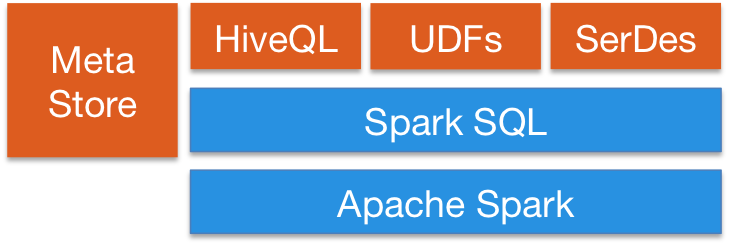Describing Apache Spark
- Spark is a distributed computing engine
- Its performance boost mostly comes from Spark storing data in memory
- Spark is run on server-side clusters
-
It provides high-level APIs in:
- Java
- Scala
- Python
- R
- We are able to run Spark on server-side clusters
Describing Higher-Level APIs in Spark
-
Spark also supports higher-level APIs:
- Spark SQL
- MLlib
- GraphX
- Spark Streaming
- Spark SQL is used for SQL and structured data processing
- MLlib is used for machine learning
- GraphX is used for graph processing
- Spark Streaming is used for streaming data
Describing Features of Spark SQL
- Integrates querying inside Spark programs
>>> # Mix SQL queries with DataFrame API
>>> results = spark.sql('SELECT * FROM people')
>>> names = results.map(lambda p: p.name)- Connects to any data source the same way
>>> # Uniform data access with DataFrame API
>>> spark.read.json('s3n://...').registerTempTable('json')
>>> results = spark.sql('SELECT * FROM people JOIN json')- Integrates with Hive

- Connects through JDBC or ODBC

Motivating the Comparison between Hive and Spark
-
Consider two types of tools used in Hadoop:
- Execution engines
- Query optimizers
- These are both individual software frameworks
- An execution engine is required in Hadoop
- A query optimizer is optional
- An execution engine processes jobs related to the data
-
A query optimizer optimizes queries before they are processed
- Sometimes, they optimize queries during processing too
Comparing Apache Hive and Spark
-
Hive is mostly referred to as a query optimizer
- This is because Hive is essentially a metastore
- Spark is mostly referred to as an execution engine
- Hive uses MapReduce as its execution engine by default
-
Spark uses its own execution engine
- It is an alternative of MapReduce
-
Spark offers query optimizers as well
- It uses catalyst optimizers
- This uses rule-based and cost-based optimization
- Spark and Hive can be used together
-
Specifically, we can include:
- HDFS as our storage layer
- Hive's metastore for query optimization
- Spark's query optimization
- Either Spark or MapReduce as an execution engine
Describing Features of MLlib
- Again, MLlib is the machine learning API in Spark
- It supports Java, Scala, Python, and R
-
MLlib provides functions for:
- Kmeans
- LogisticRegression
- etc.
-
This allows data scientists to:
- Perform clustering
- Perform classification
- Transform data
- Process data
- Run algorithms
- Specifically, these algorithms are run nearly times faster than MapReduce jobs
- MLlib supports Java, Scala, Python, and R APIs
Describing Features of Spark Streaming
- MLlib is used for writing streamed jobs the same way as writing batch jobs
- Streamed jobs are processed in real-time
-
Spark Streaming can read data from:
- HDFS
- Flume
- Kafka
- Custom data sources
- It uses ZooKeeper and HDFS for deploying streaming applications
- Spark Streaming supports Java, Scala, Python, and R APIs
Describing Features of GraphX
- GraphX is used for performing graph-parallel computation to display and work with graphics
-
It unifies the following within a single API:
- ETL
- Exploratory analysis
- Iterative graph computations
- It allows data to be viewed as graphs and collections
- Collections are transformed and joined graphs
- It offers integration with the Pregal API
- It offers comparable performance to the fastest specialized graph processing systems
- These include GraphLab and Giraph
Defining Resilient Distributed Datasets
- Spark revolves around resilient distributed datasets (RDD)
- These are a fault-tolerant collection of elements that can be operated in parallel
-
There are two ways of creating RDDs:
- Parallelizing an existing collection in the driver program
- Referencing a dataset in an external storage system
-
External storage systems include:
- HDFS
- HBase
- Other data sources offering a Hadoop InputFormat
Benefits of Spark over MapReduce
- Spark executes much faster by saving data in memory
- This happens across multiple parallel operations
- On the other hand, MapReduce reads and writes from disk
- Spark runs multi-threaded tasks inside of JVM processes
- MapReduce runs heavy-weight tasks inside of JVM processes
-
As a result, this gives Spark the following boost:
- Faster startup
- Efficient parallelism
- Better CPI utilization
- Spark provides a richer functional programming model
- MapReduce doesn't do this
- Spark is especially useful for parallel processing of distributed data with iterative algorithms
References
Previous